2023.08.02.89
Files > Volume 8 > Vol 8 No 2 2023
Response of potatoes planted in Gypsifrious soil to organic, biological and mineral fertilization
Najm Abdallah, Sahar Alhamadani and Ali Abbas Kadhum*
College of Agriculture/University of Anbar; Department of Soil and Water Resources; [email protected]
* Correspondence: [email protected]
Available from: http://dx.doi.org/10.21931/RB/2023.08.02.89
ABSTRACT
This experiment was conducted during the growing season 2021, the spring bloom, in the AL-Falluja date palm research station province fellow Horticulture board/Ministry of Agriculture. To study the effect of organic fertilizer and inoculation on P. pseudomonas bacteria and fungi. Trichoderm harzanium and mineral fertilizer in the growth and yield of potato variety Burren, the experiment included three factors, the first factor, adding two levels of fermented organic fertilizer 10 tons hectares of sheep waste (C1) and without addition of organic fertilizer (C0) As for the second factor, it included the addition of biological fertilizer (Pseudomonas and Trichoderma bacterial vaccine): without adding the vaccine B0 + adding the bacterial vaccine Pseudomonas B1 + adding the fungal vaccine Trichoderma (B2) and the addition of a mixture of the bacterial Pseudomonas vaccine and the fungal Trichoderma vaccine (B3), and the third factor was the addition of three levels of mineral fertilizer, which is 50 % of the recommended fertilizer (M50) and 75% of the fertilizer recommendation (M75) and the addition of the fertilizer recommendation 100 % (M100) and the results of the study are summarized as follows: The use of organic fertilizer led to a significant increase in growth characteristics and yield of potatoes as a result of the addition of fertilizer aleudwiu Treatment O1 gave the highest rate of the studied traits, number and weight of tubers, which amounted to 7.91 tubers. plant-1 and 78.03 g. Plant-1 and the yield of one plant is 634.9 g.Plant-1, and the total yield is 36.91 mg.h-1 The total marketable yield 35.53 mcg ha-1. There was a significant increase in the growth characteristics and yield of potato plants due to the addition of bio-fertilizer, as it gave the interaction treatment between Pseudomonas bacteria and Trichoderma (B3). The highest rates in the studied traits, as the number and weight of tubers, reached 9.11 tubers. plant-1 and 86.22 g. Plant-1 and the yield of one plant is 796.0 g. plant-1 The total yield is 39.03 mcg ha-1 and the total marketable yield is 37.71 mcg ha-1. The addition of the fertilizer M100 led to a significant increase in the growth characteristics and yield of the plant Potatoes, as the number and weight of tubers reached 8.10 tubers: plant-1 and 76.88 g. Plant-1 and the yield of one plant is 634.9 g.plant-1, total yield 36.26 mcg ha-1, total marketable yield 35.05 mcg ha-1. The double and triple interactions increase the results in growth characteristics, chemical content, growth characteristics and yield
Keywords: potatoes, organic fertilization, bio fertilization, mineral fertilization, yield.
INTRODUCTION
Potato (Solanum tuberosum L.), belonging to the Solanaceae family, is the third food crop after wheat and rice. It is also the most essential crop type because it contains protein, starch, and vitamins. In Iraq, the area planted with the potato crop is estimated at (39,000) hectares and a production rate of (16,036) tons per hectare1.
They are adding organic matter to the activity of soil biology, as these wastes are decomposed by mineralizing the organic matter of the elements. Vegetables added to Field soil are from the residues of crops, and organic materials can be added, which are secretions from leaves and root secretions 2.
Adding it with organic fertilizers increases the effectiveness of biological fertilizers, which leads to increased crop production clearly3.
Microorganisms that live in the soil play essential roles due to their biological activity. They are important in the energy flow and the cycle of nutrients, leading to an increase in agricultural production; the most important groups of organisms that live in the soil are fungi, bacteria, algae, protozoa, and earthworms. The presence of organic and bio-fertilizers and the increase of organic matter in the soil increases the activity of microorganisms in the soil, and bacteria that stimulate plant growth (PGPR) are essential for many crops; the different types of PGPR eliminate many plant diseases and facilitate plant growth either directly or indirectly, as well as decomposition of organic matter4. 5 found a significant increase in the growth parameters of potato plants, such as the total yield, plant height and the number of aerial stems, as well as an increase in the activity of microorganisms in the soil (bacteria and fungi) when adding decomposed organic matter from the residues of cows, sheep and horses by 40 tons h-1.
Pseudomonas bacteria are organisms that secrete plant hormones that encourage plant growth; in addition to cytokinin, they secrete an enzyme (Acc-deaminase) that inhibits the presence of ethylene. Pseudomonas bacteria have a role in increasing the efficiency of phosphorus processing and the readiness of zinc and iron6.
Trichoderma uranium is one of the beneficial fungi that is used in the field of biocontrol on a large scale. Experiments in many countries have shown that the fungus Trichoderma has a substantial effect in the agricultural area, significantly increasing the availability of nutrients such as nitrogen, phosphorous and potassium through the secretion of some enzymes and its high ability to decompose existing or added organic matter to the soil, as well as its high ability to give the plant host resistance against pathogens 7 and 8.
9 When adding organic matter (sheep, poultry and horse manure) in interaction with Biofertilizer (Azotobactre chroococcum, Pseudomonas florecienis) the organic matter contributed either alone or in combination with growth-stimulating bacteria.
The macronutrients are among the factors that affect the plant's yield because of their importance in forming the vegetative and root systems and yield. Among the most important of these macronutrients are nitrogen, phosphorous and potassium. These nutrients come from mineral fertilizers added to the soil, as these mineral fertilizers are characterized by their high prices. Especially when it is used more than the need of crops, which sometimes causes some problems related to soil pollution. Therefore, there was a need to apply a new technique that depends on adding bio-fertilizers, which consist of microorganisms improved for plant growth. These microorganisms are prevalent in the soil, encouraging their isolation, diagnosis and development to produce cheap biofertilizers compared to mineral fertilizers. Decades ago, attention was drawn to reducing some of the mineral fertilizers by adding biofertilizers to improve the quality of food production and maintain ecological balance 10. 11 found in their study conducted to find out the effect of the interaction between organic fertilization and mineral fertilization fertilizer at four levels (0, 50%, 75%, 100%) of the fertilizer recommendation approved in his study12 The results of the spring season showed that the 100% treatment gave the concentration of nitrogen and potassium in the leaves, which amounted to 2.07% and 3.65%, respectively, compared to the comparison treatment, which gave a concentration of 1.25% and 2.71%, respectively. The 100% treatment was superior in the mean tuber weight, per plant yield and total yield compared to the comparison treatment. The study aimed to know the effect of organic, bio and mineral fertilizers and their interaction on potato plants' yield characteristics.
MATERIALS AND METHODS
This study was conducted during the spring season 2021, the spring bloom, in the AL-Falluja date palm research station province fellow Horticulture board/Ministry of Agriculture. To study the effect of organic matter and Biofertilizer on Pseudomonas florecienis, Trichoderma uranium and mineral fertilizer on vegetative growth characteristics and chemical content Quotient recipes, a factorial experiment RCBD was designed with three replicates. These samples were taken to conduct some chemical and physical analyses, the results of which are presented in Table (1).
Study factors:
The first factor is organic fertilizer. Adding two levels of fermented organic fertilizer: without adding organic fertilizer C0, Add organic fertilizer (C1),
The second factor is comparison, denoted by the symbol (B0), Adding the bacterial vaccine Pseudomonas (B1 ) and the Trichoderma (B2). , Addition of the bacterial vaccine Pseudomonas and the addition of the fungal vaccine Trichoderma ( B3 )
The third factor: The following levels were added: Add half of the fertilizer recommendation (M50), Add 3/4 of the quantity at a rate of 75% fertilizer recommendation (M75), Add the total amount of fertilizer (M100).
The recommended fertilizer is 250 kg N.h-1 and 50 kg N.h-1, and potassium is 400 kg, depending on the source 13.
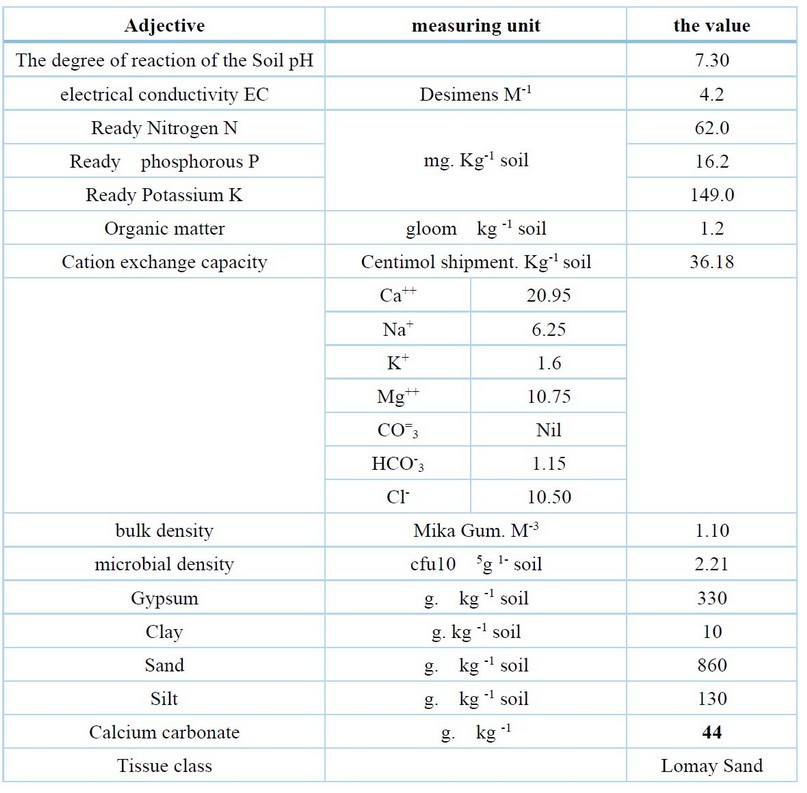
Table 1. Some chemical and physical properties of field soil before planting
Add the Bacterial vaccine after preparing the bacterial vaccine from the bacteria Pseudomonas. The tubers were contaminated with the liquid nutritional medium prepared in advance, immersing the tubers in the nutrient medium for half an hour to ensure cell adhesion to the tubers. Local isolates of a vaccine from the Agricultural Research Service. Ministry of Science and Technology, 14.
Sheep residues were added to the soil after obtaining it from the place near the implementation site, searching in a pit of dimensions (2 x 3 x 0.5) m. The organic waste was taken out of the pit on September 20, 2021, and it was spread on nylon to dry and then filled with bags until use, and an amount of 10 tons/hectare was added. The organic waste was added to make a longitudinal incision and mixed with the soil, and then a longitudinal incision was made for planting the tubers.
Qualities and components: The process of harvesting the yield was carried out on 6/1/2021, and ten plants were randomly selected from each experimental unit to calculate the characteristics of the product as follows:
The number of tubers per plant (tuber plant-1), average tuber weight (gm tuber-1 ) , Average yield per plant (gm plant-1, Total yield (ton ha-1), and Total marketable yield (ton ha-1).
RESULTS
Number and weight tuber(tuber. plant-1) (g. tuber-1)
The results mentioned in Table (2 and 3) showed that the average number and weight of tubers increased due to adding organic fertilizer, as treatment O1 was superior by giving it the highest rate of 7.91 tubers. Plant-1, 78.03 gm tuber-1 sequentially, while the control treatment O0 gave the lowest rate of 7.25 tuber.plant-1, 67.42 gm tuber-1 sequentially, and we note significant differences due to the treatment with bio-fertilizer, as treatment B3 was unique in giving it the highest rate of 9.11 tuber. Plant-1 86.22, gm tuber-1, then treatment B2 followed by a rate of 8.27 tuber.plant-1, 77.83 gm tuber-1 in sequence, while treatment gave the lowest rate of 5.67 tuber.plant-1, 57.61 gm tuber-1. The results of the same Table also indicated significant differences due to the treatment with mineral fertilizer, as the treatment M100 gave the highest rate of 8.10 tuber.plant-1,76.88 gm.tuber-1 in sequence, Then it was followed with a significant difference by treatment M75, giving it an average of 7.49 tuber.plant-1, 73.29 gm tuber-1 in sequence, while treatment M50 gave the lowest rate of 7.14tuber.plant-1. 68.00gtuber-1.sequentially, the results of Table (3) indicated significant differences in the average number and weight of tubers per plant as a result of an interaction between organic and biological fertilizers, as the treatment O2B3 gave the highest rate of 9.74 tubers. Plant-191.44 gm tuber-1 sequentially, while treatment O0B0 gave the lowest rate of 5.44 gm tuber-1, 54.89 gm tuber-1 sequentially.
The results of Tables (2 and 2) also indicated that there was a significant superiority in the rate of the number of tubers as a result of the interaction of organic and mineral fertilizers, where the treatment O1M100 gave the highest rate of the number and weight of tubers reached 8.39 tubers. Plant-1,82.50 gm tubers-1, Whereas the treatment O0M50 gave the lowest rate of 6.88 tubers. Plant-1. 62.75 gm tuber-1 sequentially, as the results of Tables (2 and 3) show the significant superiority of the average number and weight of tubers per plant as a result of the interaction of bio-fertilizer and mineral fertilizer,
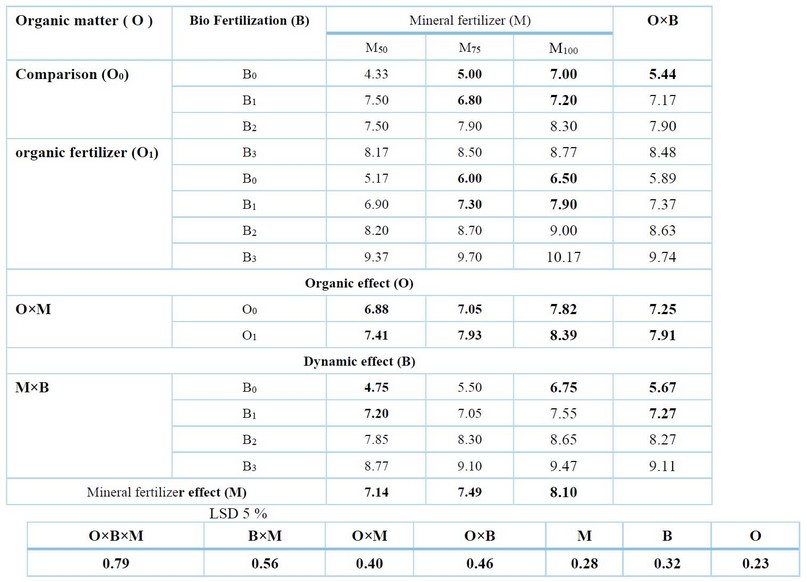
Table 2. The effect of organic, bio and mineral fertilization on the number of tubers (tuber.plant-1)
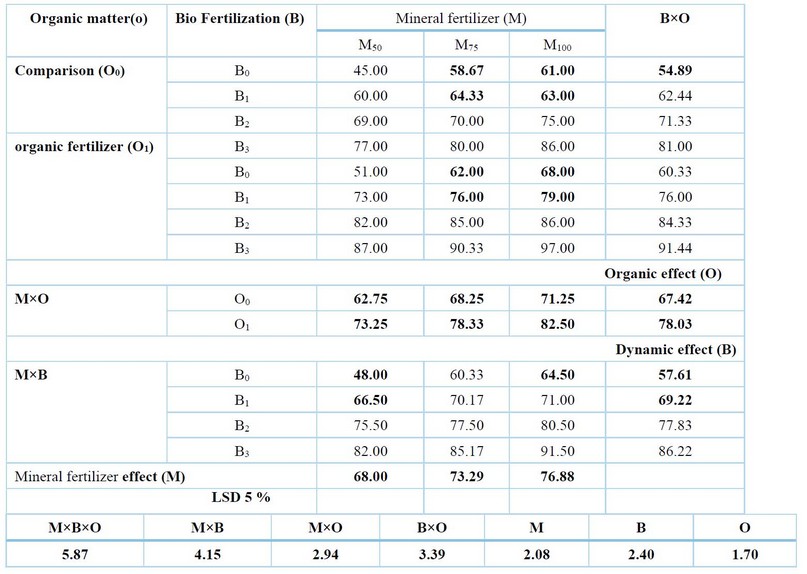
Table 3. Effect of organic, bio and mineral fertilization on average tuber weight (gm tuber-1)
as the treatment B3M100 gave the highest rate of 9.47 tubers Plant-1, 91.50 gm tuber-1 sequentially, while treatment B0M50 gave the lowest rate of 4.75 tuber.plant-1. 48.00 gm tuber -1 sequentially. Table (2 and 3) showed the significant effects of the interaction of the three study factors, as the treatment O1B3M 100 gave the highest average number and weight of tubers, reaching 10.17 tuber.plant-1,97.00 gm tuber-1 sequentially, while it gave Treatment O0B0M50, the lowest rate was 4.33 tuber. Plant-1. 45.00 gm tuber -1 sequentially.
Yield per plant (gm plant-1)
It is noticed from the results of Table (4) that there are significant differences due to adding organic fertilizer in the yield of one plant, as the O1 treatment gave the highest yield per plant, reaching 634.9 gm plant-1. In contrast, the comparison treatment gave the lowest rate of 502.2 gm plant-1. As for the effect of adding bio-fertilizer, the results indicate the superiority of the B3 treatment by giving the highest plant yield of 796.0 gm plant-1, compared to the yield of one plant in the control treatment, which amounted to 328.3 gm plant-1. The treatment of the entire fertilizer recommendation M100 achieved the highest plant yield of 634.9 gm plant-1, compared to the one plant in the control treatment M50, which amounted to 507.7 gm plant-1. As for the effect of the interaction between organic and biological fertilizers, the results show a significant difference, as the treatment O1B3 excelled by giving it the highest yield of 892.1 gm plant-1. In comparison, the treatment O0B0 gave the lowest yield of 298.1 gm plant-1 per plant. As for the bilateral interaction between organic and mineral fertilizers, it had a significant effect, as the results of Table (4) showed significant differences,
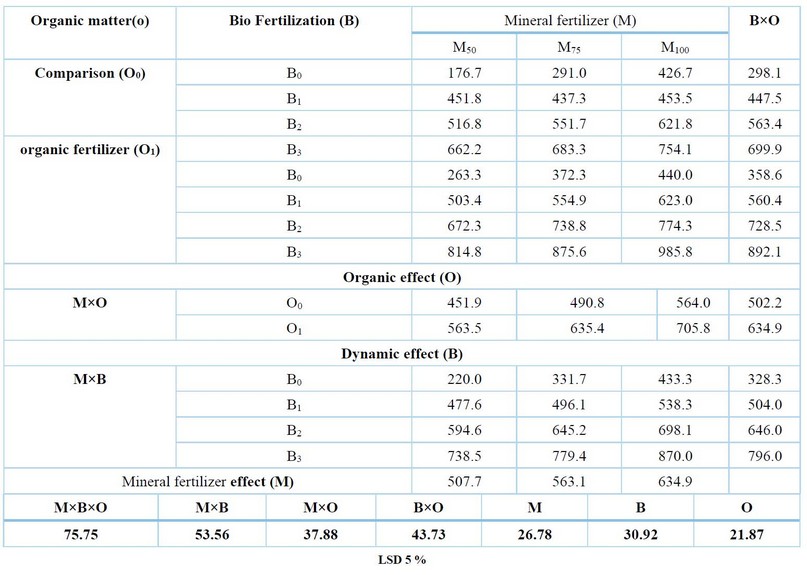
Table 4. The effect of organic, bio and mineral fertilization on the rate of one yield (gm plant-1)
As the treatment, O1M100 gave the highest average yield per plant of 705.8 gm plant-1, while the treatment O0M50 gave the lowest rate of 451.9 gm plant-1. The results of Table (4) showed a significant effect on the rate of yield per plant due to the interaction of biological and mineral fertilizers, where treatment B3M100 gave the highest rate of 870.0 gm plant-1. In comparison, treatment B0M50 gave the lowest rate of 220.0 gm plant-1. As for the triple interaction, the results of Table (4) indicate that there are significant differences, as treatment O1B3M100 gave the highest average yield per plant, reaching 985.8 gm plant-1, compared to treatment D0B0M50, which gave the lowest rate of 176.7 gm plant-1.
Total yield and marketable yield (mg .h -1)
The effect of adding organic, biological and mineral fertilizers on the total yield and marketable yield of potato plants (mcg ha-1), The organic fertilizer treatment was significantly superior by achieving 36.91 mcg ha-1 and 35.53 mcg ha-1, respectively, compared to the control treatment (Table 5 and 6). Through the results, the effect of biological fertilization on potato plants' total yield and marketable yield shows that treatment B3 was significantly superior, as it achieved the highest yield of 39.03 and 37.71 mcg. Transaction B2 ha-1sequentially followed them By giving it a total and marketable yield of 37.25, 35.91 mg. ha-1sequentially Compared to the comparison treatment that gave the lowest rate of 26.31, 26.31 mcg. ha-1 sequentially. The results showed a significant effect of mineral fertilization, as the M100 treatment was superior, which amounted to 36.26, 35.05 mcg.ha-1, and 35.05, respectively, compared to the control treatment (M50), which amounted to 31.44, 29.66 mcg.ha-1, respectively. The results of the bilateral interaction between bio and organic fertilizers showed the superiority of (O1 B3) treatment over all the dual interaction treatments, as this treatment achieved a significant difference of 42.43 and 40.99 mcg.ha-1, respectively, compared to the control treatment (B0O0), which gave 23.67, 21.03 mcg. ha-1sequentially. The treatment O1M100 significantly outperformed the other interaction treatments and gave the highest rates of 38.87, 37.65 mcg. ha-1sequentially, compared to treatment O0M50, which gave the lowest average of 28.80 and 26.79 mcg. ha-1sequentially.
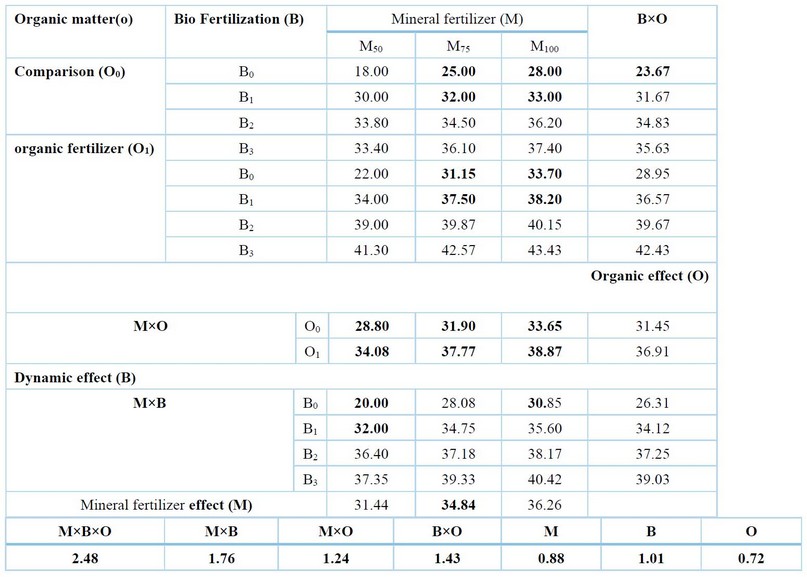
Table 5. The effect of adding organic, biological and mineral fertilizers on the total yield of potato plants (mcg ha-1)
From the same Table, it was found that the bilateral interaction between bio-fertilizer and mineral fertilization had positive results, as the treatment B3M100 outperformed and achieved a value of 40.42, 39.15 mcg ha-1, respectively, compared to the non-addition treatment B0M50, which gave the lowest value of 20.00, 17.38 mcg. ha-1sequentially. The triple interaction between the biological fertilizer and the organic and mineral fertilizer shows a clear significant difference between the treatments, as the treatment B3O1M100 gave the highest total yield and marketable yield, which amounted to 43.43, 42.37 mcg. ha-1 sequentially, compared to the no-addition treatment B0O0M50 which gave 18.00, 14.80 mcg ha-1 sequentially.
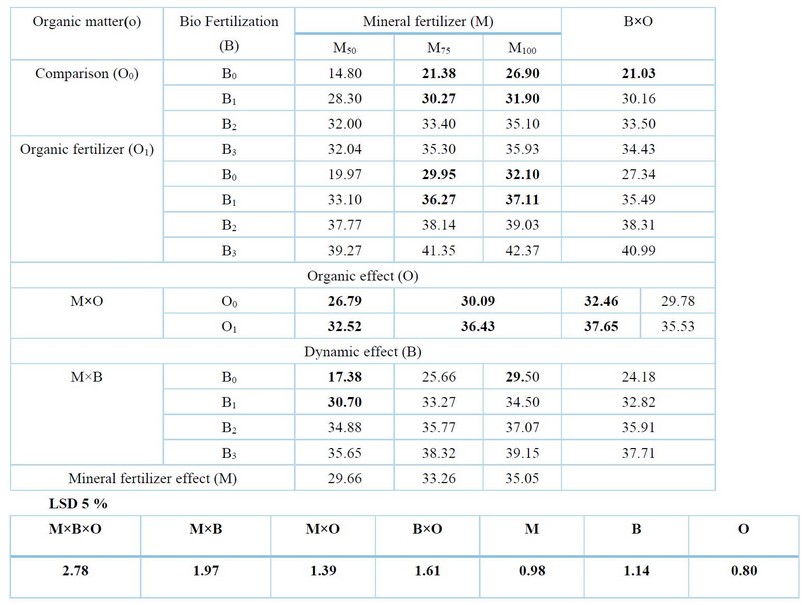
Table 6. Effect of organic, bio and mineral fertilization on marketable yield (mcg ha-1)
DISCUSSION
The main reason for the increase in the characteristics mentioned in Tables (3, 4, 5 and 6) may be due to the components of the added organic fertilizer that contains many nutrients, in addition to the fact that its components are decomposed and thus stimulate the growth of the plant from By providing the macro and micronutrients that the plant needs to increase the yield characteristics of the potato plant, and this was confirmed by 15 in her study on the effect of organic fertilizer on the yield of potatoes, as this fertilizer gave the highest values of growth indicators for potato plants, which is positively reflected on the characteristics of the crop. It may be attributed to the fact that bio-fertilizers increase the concentration of some nutrients in the soil, especially nitrogen and phosphorous, through multiple mechanisms that increase the concentration of nitrogen and phosphorous in the plant to increase with it carbohydrates and protein in the tubers, thus reflecting on the value of the total yield, Biofertilizer also has a significant impact on the number of tubers and the total yield of potato plants through its effect in providing the nutritional needs of the plant 16. This indicates the importance of biofertilizers (bacteria and fungi) in stimulating the growth of roots through their secretion of growth regulators that increase cell division and form a good root system that helps the plant absorb nutrients to carry out its vital operations. This interference effect is Positive in increasing the total yield of the plant; the organic fertilizer improves the work of microorganisms, which improves the growth and productivity of the plant 16. The reason for the superiority of the fertilizer recommendation over the rest of the mineral levels can be attributed to the role of mineral fertilizer in providing nutrients and organic fertilizer that improves the physical properties as it helps the roots and increase the absorption of elements and water, and that these two factors contribute to the formation of a good root system that is reflected in the number of tubers Which in turn affects the total yield of the plant. The availability of the plant's need for nutrients is positively reflected in the manufacturing processes of energy compounds that take place in the plant to be stored in the tubers to increase the tuber weight and then the total yield of the plant 17.
CONCLUSIONS
This may be attributed to the high response of the potato plant to the mineral fertilization for the readiness of the elements in the soil solution, which improves the vegetative growth characteristics of the potato plant to reflect on the total yield of the potato plant, and these results are consistent with what was mentioned by 18. On the importance of the role of mineral fertilizer for plants to carry out its vital activities, the most important of which is photosynthesis, which reflects positively on the total yield of the plant The reason for this may be due to the activity of microorganisms, which increased by increasing the availability of the elements present in the soil and added as mineral fertilizers to result in this activity dissolving the nutrients in the soil and preparing them for the plant to carry out its vital operations, which is reflected in the yield of one plant and then the yield of the total plant, and this is consistent with 19 Which confirmed that the reason for the increase in the number of tubers and the total yield of the potato plant is due to the role of the active microbiology in the rhizosphere, which increases the readiness of the unready nutrients as well as the mineral fertilizer added to increase the total yield of the plant.
REFERENCES
1. Al Rubaye , A.T. A. Abdul-Ratha and A.H. Adown. Effect of local and imported biofertilizers on growth and yield of potato. Iraqi Journal of Agricultural Sciences2018. 1029:50(1):132-114.
2. Ahmed A.M. Abdallah, A.A. Gad, A. Bardisi and Dalia A.S. Nawar. Effect of Organic, Mineral and Bio-Nitrogen Fertilization on Growth and Productivity of Some Snap Bean Cultivars Grown in Clay Soil. Zagazig J. Agric. Res. . 2018. Vol. 45 No. (1): 105-117.
3. Ali Noureddine Shawky. Fertilizer technologies and their uses. 2011. College of Agriculture - University of Baghdad - under publication.
4. Kumar,A. and J.P. Verma, .Does plant—microbe interaction confer stress tolerance in plants: a review? MicrobiolRes. . 2017.( 207), pp. 41-52
5. Al-Maamiri, Ali Abbas Kazem. Effect of adding organic matter and some microbial inoculums on the fungus Solani Rhizoctonia. . 2012. PhD thesis - College of Agriculture - Department of Soil Sciences and Water Resources - University of Baghdad.
6. Al-Shammari, Muhammad Ibrahim.. Effect of bacterial bio-vaccine and biozyme spraying on growth, yield and qualitative characteristics of two potato cultivars. . 2018 Master Thesis . College of Agriculture, University of Anbar.
7. Harman, G.E.. Myths and dogmas of biocontrol Plant Disease. 2000. 84 (4): 377-393.
8. Oksana V. Tkachenko1 & Nina V. Evseeva2 & Natalya V. Boikova1 & Larisa Yu. Matera. Improved potato microclonal reproduction with the plant growth-promoting rhizobacteria Azospirillum. Agron. Sustain. 2015. Dev. (2015) 35:1167–174 DOI 10.1007/s13593-015-0304-3.pepper plants. Recent technologies in agriculture. Faculty of Agriculture,
9. Thuwaini, Qutaiba Salal. Effect of adding organic matter and microorganisms stimulating plant growth in controlling black scale disease and potato growth and yield . 2017. Master Thesis . College of Agriculture, University of Anbar.
10. Khairi, I. R. .; Salman, M. A. . Effect Of Plant Growth Regulators On In Vitro And Ex Vitro Conditions On Propagation Of Dianthus Caryophllus L. JLSAR 2021, 2, 54–6.
11. Hussein, Hamad Jaber and Jamal Ahmad Abbas. Effect of organic and chemical fertilization on some indicators and yield of potatoes. Jordanian Journal of Agricultural Sciences. 2017 . Vol.13: Issue 2.
12. Al-Zobaie, Salam Zakum. Determination of nitrogen, phosphorous and potassium balance of potatoes in alluvial soil. 2000.. PhD thesis. Department of Soil and Water Sciences - College of Agriculture - University of Baghdad.
13. Kormanik J.W .;Leong J. ; Teintze M. and Schroth M.N. Enhanced. Plant growth by siderophores is produced by plant growth promoting rhizobacteria . 1980. Nature, 286:885-886
14. Al-Kazemi, Nadine Aziz Salman,. Effect of organic fertilizer source and mineral fertilizer level on growth and yield of potatoes. 2017. Master's Thesis - College of Agricultural Engineering Sciences.
15. Singh, M.; S. K.Biswas ; D.Nagar ; K. Lal, J.Singh . Impact of Biofertilizer on growth parameters and yield of potato. Int. J. Curr. Microbiol. Appl. Sci, 2017. 6 (5): 1717-1724.
16. Pathak, D.; R.Lone and K. K. Koul. Arbuscular Mycorrhizal Fungi (AMF) and Plant Growth-Promoting Rhizobacteria (PGPR) Association in Potato (Solanum tuberosum L.) : A Brief Review. In Probiotics and Plant Health. 2017. (pp. 401-420). Springer, Singapore.
17. Narayan , S .; R. H. Kanth ; R.Narayan ; F. A. Khan; P.Singh and S. U. Rehman. Effect of integrated nutrient management practices on yield of potato potato Journal. 2013. (40): 1.
18. Alkhateeb, A. R. .; Ibrahim, W. .; Taha, A. A. . Correlation Between Udder Conformation With Daily Milk Yield Of Buffaloes. JLSAR 2021, 2, 61–65.
19. Mohammadi, G. R.; A. R.Ajirloo ; M. E.Ghobadi and A.Najaphy. Effects of non-chemical and chemical fertilizers on potato (Solanum tuberosum L.) yield and quality. Journal of Medicinal Plants Research. 2013 . 7 (1): 36-42.
Received: May 15, 2023/ Accepted: June 10, 2023 / Published: June 15, 2023
Citation: Sahar N; Alhamadani K. Response of potatoes Planted in Gypsifrious Soil to Organic, Biological and Mineral fertilization. Revis Bionatura 2023;8 (2) 89. http://dx.doi.org/10.21931/RB/2023.08.02.89
